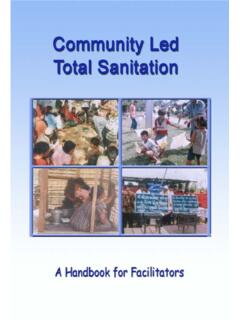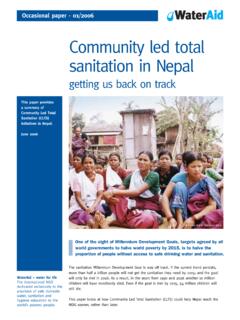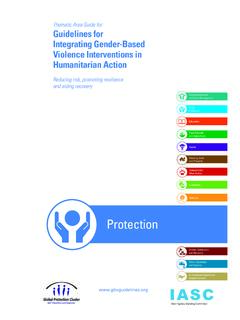Transcription of Sexual and gender based violence (SGBV) prevention ... - SSWM
1 1 Sexual and gender based violence (SGBV) prevention and responseAnyone can become a survivor of SGBV: women, men, girls, boys, of every age SGBV prevention and response programming from the start of an emergency,whether or not cases have been not forget to include men and boys when you work with communities on staff having a variety of functions in SGBV prevention : it is a UNHCR protectionpriority and a responsibility of all aside your cultural and other biases and assumptions with regard to SGBV (includingassumptions about traditional practices).1. OverviewSexual and gender - based violence (SGBV) refers to any act that is perpetrated against a person's willand is based on gender norms and unequal power relationships. It includes physical, emotional orpsychological and Sexual violence , and denial of resources or access to services.
2 violence includesthreats of violence and coercion. SGBV inflicts harm on women, girls, men and boys and is a severeviolation of several human of concern are often at heightened risk of SGBV during emergencies. This can be due to anumber of factors, including the sudden breakdown of family and community structures after forceddisplacement. Certain groups in a population may be particularly at risk of SGBV: older persons,persons with disabilities, adolescent girls, children, LGBTI persons, and female heads of may be perpetrated by anyone, including individuals from host communities, from refugee or IDPcommunities, and humanitarian actors. Persons in positions of authority (police, security officials,community leaders, teachers, employers, landlords, humanitarian workers) may abuse their power andcommit SGBV against persons of concern.
3 Changed social and gender roles or responsibilities, as wellKey document forms part of the 4th edition of the UNHCR Emergency Handbook and was generated from the digitalEmergency Handbook the stresses of displacement, can cause or exacerbate tensions within the home, sometimesresulting in domestic violence . Some harmful customary or traditional behaviours may amount to SGBV:early marriage, female genital mutilation / cutting (FGM/C), honour killing and maiming, forced situations of armed conflict, Sexual violence may be used as a weapon of and responding to SGBV is a core component of UNHCR's protection mandate. Given themulti-sectoral nature of the response it requires, UNHCR and partners should mainstream SGBV prevention throughout the emergency response and in programming across all sectors.
4 SGBV prevention and response interventions are life-saving. Programming must begin at the very outset of anemergency, irrespective of the number of reported SGBV cases. UNHCR works together withGovernments, other UN agencies, local and international NGOs and persons of concern to prevent andrespond to Protection objectivesTo protect displaced women, girls, men and boys against SGBV at all times and in all locations,including in the home, school and work, in public places, on public transport, and at aid ensure that SGBV survivors can confidentially report incidents and have timely andnon-discriminatory access to services and support, including medical, psychosocial, legal andmaterial assistance, as well as safe spaces where address the specific protection needs of persons at high risk of SGBV (including older persons,persons with disabilities, adolescent girls, children, LGBTI persons, and female heads of household)
5 And take them into account in all ensure that SGBV survivors can seek a judicial remedy if they encourage and enable persons of concern to become actively involved in protecting women, men,girls and boys against SGBV, including through community- based protection networks and Underlying principles and standardsA survivor-centred approach:o Treat every survivor with The safety of survivors and their families is Respect the choices, wishes, rights and confidentiality of survivors and their families. The identity of asurvivor should never be revealed without his or her prior Provide services and support without discrimination on any rights- based approach. Empower individuals and communities to exercise their rights, rather thanassist them as beneficiaries'.An age, gender and diversity approach. All women, men, girls and boys of all ages and diversebackgrounds should enjoy their rights on an equal footing and participate fully in decisions that protection.
6 Put the capacity, agency, rights and dignity of persons of concern atthe centre of programming. Involve communities actively and substantively in all aspects ofprogrammes that affect them. The community should be the driving force of equality and women's empowerment. gender norms and unequal power relations are theunderlying causes of SGBV: work with women, men, girls and boys to address the root causes ofSGBV and support women and girls to be leaders in their communities on an equal footing with menand boys. Please see entry on Age, gender and diversity (AGD).A life-saving intervention. SGBV prevention and response are life-saving interventions. Plan andimplementing them from the start of an emergency, without waiting for evidence of multi-sectoral approach. Involve UNHCR personnel and partners with different functions to makesure that SGBV prevention is mainstreamed throughout the Protection RisksPersons of concern may be at risk of SGBV in many different settings (at home, in public places, onpublic transport, in the workplace, at school, at aid distribution points).
7 Perpetrators may be from thehost or refugee/IDP community, from the humanitarian community, or in an official there are also communalities, SGBV-related risks in camps may differ from those inout-of-camp settings. For exampleo In camp settings, displaced people are at risk of SGBV at aid distribution points; in water, sanitationand hygiene (WASH) facilities; in unsafe shelter arrangements such as communal tents; and in areaswhere lighting is In out of camp settings, they are at risk of SGBV in public spaces such as markets; in the workplace;at and on the way to and from school; while using public transport; and at home (where they may beabused or exploited by landlords, neighbours, or other members of the household).The risk of SGBV in an emergency context is exacerbated by several factors. These include:breakdown of family and community support systems; the presence of armed forces or combatants;weak legal systems and law enforcement; abuse of power by individuals in positions of authority;laws and practices that reinforce gender discrimination; inadequate access to shelter, food, waterand fuel; and inadequate access to livelihood people are particularly at risk of SGBV during and after forced displacement, especially whenthey have been separated from or have otherwise lost the support of their relatives or include older persons, persons with disabilities, adolescent girls, children, LGBTI persons, andfemale heads of and boys are at risk of Sexual exploitation, abuse or violence by persons who care for or haveunhindered access to them, including in schools.
8 gender - based denial of resources or access toservices can also amount to SGBV; for example, girls may be denied access to school because oftheir persons of concern are dispersed in the population, in urban or rural settings, it is difficult toidentify survivors and those at risk of SGBV, or ensure their access to of SGBV is often a serious issue. Survivors may not speak out because they areashamed, stigmatized, blame themselves, fear reprisals or re-victimization, or mistrust theauthorities. As a result, survivors may not make use of services to which they are difficult social and economic conditions that people experience during displacement may drivemen, women, boys or girls to adopt negative coping strategies, such as survival Other risksUNHCR faces a reputational risk. If UNHCR and its partners do not adequately address SGBV, thismay harm UNHCR's credibility and media may demand information on SGBV cases.
9 If survivors come forward, it may put them atadditional risk, particularly when the services in place cannot meet their immediate support Key decision pointsSenior management is responsible for making sure that UNHCR and partners prioritize action to preventand respond to SGBV, as a life-saving intervention. Programming should start from the inception of anemergency, whether or not cases of SGBV have been no staff member has a specific SGBV portfolio, management should decide which protection staff willtake primary responsibility for SGBV prevention and response. As part of protection mainstreaming,managers must also ensure that colleagues with different functions within UNHCR work together onSGBV prevention , and that all programmes address it. They should also make sure that steps are takento identify people at risk, undertake prevention activities, and disseminate information about the servicesthat are should work closely with other UN agencies, Government authorities and ministries, andNGOs working on SGBV, to ensure the approach taken is collaborative.
10 SGBV prevention and responseprogrammes should fall broadly within protection and (in a refugee emergency) should be led byUNHCR. Services that meet the needs of survivors (health care, psychosocial support, legal aid) willordinarily be provided by partners. Depending on capacity, UNHCR may assume a role in individualcase management, alongside Key stepsSystems1. Appoint at least one professional member of the protection staff to be responsible for SGBV prevention and response, under the overall supervision of the Assistant Representative Protection (orequivalent position in the operation) or the senior protection Identify other actors working on SGBV prevention and response (and their focal points), inGovernment institutions, UN agencies, and local and international NGOs, as well as service providers inthe fields of health, psychosocial support, safety and security, and legal Conduct individual interviews with persons of concern, and local actors, to identify their needs,solutions, and gaps in programmes and services.











